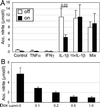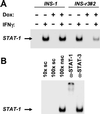Suppressor of cytokine signaling 3 (SOCS-3) protects beta -cells against interleukin-1beta - and interferon-gamma -mediated toxicity
- PMID: 11593036
- PMCID: PMC59790
- DOI: 10.1073/pnas.211445998
Suppressor of cytokine signaling 3 (SOCS-3) protects beta -cells against interleukin-1beta - and interferon-gamma -mediated toxicity
Abstract
Suppressor of cytokine signaling 3 (SOCS-3) is a negative feedback regulator of IFN-gamma signaling, shown up-regulated in mouse bone marrow cells by the proinflammatory cytokines interleukin-1beta (IL-1beta), tumor necrosis factor-alpha (TNF-alpha), and IFN-gamma. IL-1beta and IFN-gamma alone, or potentiated by TNF-alpha, are cytotoxic to the insulin producing pancreatic beta-cells and beta-cell lines in vitro and suggested to contribute to the specific beta-cell destruction in Type-1 diabetes mellitus (T1DM). Using a doxycycline-inducible SOCS-3 expression system in the rat beta-cell line INS-1, we demonstrate that the toxic effect of both IL-1beta or IFN-gamma at concentrations that reduced the viability by 50% over 3 days, was fully preventable when SOCS-3 expression was turned on in the cells. At cytokine concentrations or combinations more toxic to the cells, SOCS-3 overexpression yielded a partial protection. Whereas SOCS-3-mediated inhibition of IFN-gamma signaling is described in other cell systems, SOCS-3 mediated inhibition of IL-1beta signaling has not previously been described. In addition we show that SOCS-3 prevention of IL-1beta-induced toxicity is accompanied by inhibited transcription of the inducible nitric oxide synthase (iNOS) by 80%, resulting in 60% decreased formation of the toxic nitric oxide (NO). Analysis of isolated native rat islets exposed to IL-1beta revealed a naturally occurring but delayed up-regulated SOCS-3 transcription. Influencing SOCS-3 expression thus represents an approach for affecting cytokine-induced signal transduction at a proximal step in the signal cascade, potentially useful in future therapies aimed at reducing the destructive potential of beta-cell cytotoxic cytokines in T1DM, as well as other cytokine-dependent diseases.
Figures






Similar articles
-
Double-stranded ribonucleic acid (RNA) induces beta-cell Fas messenger RNA expression and increases cytokine-induced beta-cell apoptosis.Endocrinology. 2001 Jun;142(6):2593-9. doi: 10.1210/endo.142.6.8188. Endocrinology. 2001. PMID: 11356709
-
Suppressor of cytokine signaling 1 protects rat pancreatic islets from cytokine-induced apoptosis through Janus kinase/signal transducers and activators of transcription pathway.Chin Med J (Engl). 2013 Nov;126(21):4048-53. Chin Med J (Engl). 2013. PMID: 24229672
-
Regulation by cytokines of the inducible nitric oxide synthase promoter in insulin-producing cells.Diabetologia. 1998 Sep;41(9):1101-8. doi: 10.1007/s001250051036. Diabetologia. 1998. PMID: 9754830
-
The harmony of the spheres: inducible nitric oxide synthase and related genes in pancreatic beta cells.Diabetologia. 1996 Aug;39(8):875-90. doi: 10.1007/BF00403906. Diabetologia. 1996. PMID: 8858209 Review.
-
A new role for SOCS in insulin action. Suppressor of cytokine signaling.Sci STKE. 2003 Feb 11;2003(169):PE6. doi: 10.1126/stke.2003.169.pe6. Sci STKE. 2003. PMID: 12582200 Review.
Cited by
-
Conditional ablation of HDAC3 in islet beta cells results in glucose intolerance and enhanced susceptibility to STZ-induced diabetes.Oncotarget. 2016 Sep 6;7(36):57485-57497. doi: 10.18632/oncotarget.11295. Oncotarget. 2016. PMID: 27542279 Free PMC article.
-
In vitro phenotypic, genomic and proteomic characterization of a cytokine-resistant murine β-TC3 cell line.PLoS One. 2012;7(2):e32109. doi: 10.1371/journal.pone.0032109. Epub 2012 Feb 29. PLoS One. 2012. PMID: 22393382 Free PMC article.
-
The target cell response to cytokines governs the autoreactive T cell repertoire in the pancreas of NOD mice.Diabetologia. 2009 Feb;52(2):299-305. doi: 10.1007/s00125-008-1193-7. Epub 2008 Nov 25. Diabetologia. 2009. PMID: 19031069
-
JunB Inhibits ER Stress and Apoptosis in Pancreatic Beta Cells.PLoS One. 2008 Aug 21;3(8):e3030. doi: 10.1371/journal.pone.0003030. PLoS One. 2008. PMID: 18716665 Free PMC article.
-
Inhibition of the IL-18 Receptor Signaling Pathway Ameliorates Disease in a Murine Model of Rheumatoid Arthritis.Cells. 2019 Dec 18;9(1):11. doi: 10.3390/cells9010011. Cells. 2019. PMID: 31861496 Free PMC article.
References
-
- Mandrup-Poulsen T, Bendtzen K, Nerup J, Dinarello C A, Svenson M, Nielsen J H. Diabetologia. 1986;29:63–67. - PubMed
-
- Bendtzen K, Mandrup-Poulsen T, Nerup J, Nielsen J H, Dinarello C A, Svenson M. Science. 1986;232:1545–1547. - PubMed
-
- Mandrup-Poulsen T, Egebjerg J, Nerup J, Bendtzen K, Nielsen J, Dinarello C. Acta Pathol Microbiol Immunol Scand Sect C. 1987;95:55–63. - PubMed
-
- Nerup J, Mandrup-Poulsen T, Helqvist S, Andersen H U, Pociot F, Reimers J I, Cuartero B G, Karlsen A E, Bjerre U, Lorenzen T. In: New Horizons in Diabetes Mellitus and Cardiovascular Disease. Schwartz C J, Born G V R, editors. London: Science Press; 1995. pp. 57–63.
-
- Eizirik D L, Flodström M, Karlsen A E, Welsh N. Diabetologia. 1996;39:875–890. - PubMed
Publication types
MeSH terms
Substances
LinkOut - more resources
Full Text Sources
Research Materials
Miscellaneous

